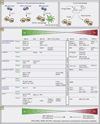Macrophage activation and polarization: nomenclature and experimental guidelines
- PMID: 25035950
- PMCID: PMC4123412
- DOI: 10.1016/j.immuni.2014.06.008
Macrophage activation and polarization: nomenclature and experimental guidelines
Abstract
Description of macrophage activation is currently contentious and confusing. Like the biblical Tower of Babel, macrophage activation encompasses a panoply of descriptors used in different ways. The lack of consensus on how to define macrophage activation in experiments in vitro and in vivo impedes progress in multiple ways, including the fact that many researchers still consider there to be only two types of activated macrophages, often termed M1 and M2. Here, we describe a set of standards encompassing three principles-the source of macrophages, definition of the activators, and a consensus collection of markers to describe macrophage activation-with the goal of unifying experimental standards for diverse experimental scenarios. Collectively, we propose a common framework for macrophage-activation nomenclature.
Copyright © 2014 Elsevier Inc. All rights reserved.
Figures

References
-
- Biswas SK, Mantovani A. Macrophage plasticity and interaction with lymphocyte subsets: cancer as a paradigm. Nat Immunol. 2010;11:889–896. - PubMed
Publication types
MeSH terms
Substances
Grants and funding
- AI080621/AI/NIAID NIH HHS/United States
- MR/J001899/1/MRC_/Medical Research Council/United Kingdom
- R01 AI080621/AI/NIAID NIH HHS/United States
- 087520/WT_/Wellcome Trust/United Kingdom
- R01 AI046712/AI/NIAID NIH HHS/United States
- AI062921/AI/NIAID NIH HHS/United States
- R37 AI018797/AI/NIAID NIH HHS/United States
- R21 AI097485/AI/NIAID NIH HHS/United States
- ImNIH/Intramural NIH HHS/United States
- R01 AI018797/AI/NIAID NIH HHS/United States
- MR/K01207X/1/MRC_/Medical Research Council/United Kingdom
- R01 GM102589/GM/NIGMS NIH HHS/United States
- R01 HL084312/HL/NHLBI NIH HHS/United States
- AI18797/AI/NIAID NIH HHS/United States
- R01 AI044938/AI/NIAID NIH HHS/United States
- P30 CA21765/CA/NCI NIH HHS/United States
- 095831/WT_/Wellcome Trust/United Kingdom
- P30 CA021765/CA/NCI NIH HHS/United States
- R01 AI062921/AI/NIAID NIH HHS/United States
- HL084312/HL/NHLBI NIH HHS/United States
- R56 AI018797/AI/NIAID NIH HHS/United States
LinkOut - more resources
Full Text Sources
Other Literature Sources
Medical

